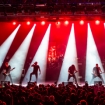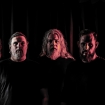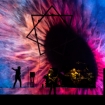Get Meshuggah vinyl, including exclusive, limited-edition colored vinyl variants at the Revolver shop.
Many influential bands emerged out of metal's transitional era in the late Eighties and early Nineties, but there might be only one that single-handedly created their own style of music. Formed in Umeå, Sweden, in 1987, Meshuggah started as young thrash enthusiasts with a mild jazz-fusion streak, but by the mid-Nineties they were pioneering the staccato, polyrhythmic subgenre that would eventually become known as djent.
Like just about any musical genre you'd care to name, djent didn't just burst into existence fully formed. Instead, Meshuggah slowly developed it over the course of their 30-plus-year career. There was at least one big stylistic leap — from their 1991 debut, Contradictions Collapse, to 1995's Destroy Erase Improve — but after that, Meshuggah became progenitors in gradual increments. By experimenting with 8-string guitars, cutting-edge drum software and new programming techniques, core members Jens Kidman (vocals), Fredrik Thordendal (guitars), Mårten Hagström (guitars) and Tomas Haake (drums) — along with "new guy" Dick Lövgren (bass) — honed their signature sound.
Meshuggah's ninth and latest album, Immutable, is proof positive that the veteran Swedes are still pushing metal's boundaries forward while remaining totally committed to their singular musical vision. As ever, walloping tracks like "The Abysmal Eye," "Light the Shortening Fuse" and "I Am That Thirst" deliver jackhammer riffs, inhuman drumming and subtle sci-fi melodies alongside astute social and technological commentary.
Haake recently took Revolver on a stroll down memory lane to discuss each album in Meshuggah's musical journey.
Contradictions Collapse
Back in the late Eighties and early Nineties, Meshuggah were a much different band than the one we know today. Exhibit A? Their 1991 full-length debut, Contradictions Collapse. At this point, vocalist Jens Kidman was still playing guitar, drummer Tomas Haake was a relatively new addition, and guitarist Mårten Hagström had yet to join. More to the point, the music they were making was much closer to traditional thrash than the groundbreaking djent style they would eventually create. "It was very much a mix of thrash with a kind of Allan Holdsworth–style fusion," Haake says. "You can definitely hear the Metallica and the Anthrax in the guitars. That's what we were into at the time."
Shortly after joining Meshuggah, Haake had to begin his compulsory stint in Sweden's military — far away from the rest of the band. Because this made rehearsing almost impossible, Nuclear Blast founder Markus Staiger wrote a series of letters to the Swedish military asking that the drummer be moved to a base closer to the band's Umeå headquarters. They relented, and Haake found himself stationed at the same facility where guitarist Fredrik Thordendal was completing his service. "We rehearsed 14 hours straight for Contradictions Collapse before we went into the studio, eating nothing but candy," Haake recalls with a laugh. "But we were 20 years old back then, so we could do that sort of thing."
Destroy Erase Improve
By 1995, Meshuggah had shed most of their thrash trappings and were beginning to solidify the sound that would make them famous. Destroy Erase Improve marked this dramatic shift and gave the metal underground a much-needed jolt. "Besides Pantera and a few other bands, metal felt kind of dead for a few years between '90 and '95," Haake says. "Grunge had taken over everything. But by the end of that period, you had new bands like Fear Factory and Machine Head getting big. It felt like that kind of shift made the timing right for Destroy Erase Improve. And our first big tour was opening for Machine Head for 10 weeks in Europe, which really helped expose us to fans."
After Contradictions, Kidman put aside his guitar and decided to focus on vocals. With Hagström now onboard, Destroy Erase Improve marked the beginning of a new era for Meshuggah. "When we went into the studio to record it, half of the songs weren't even done," Haake recalls. "We ended up putting them together quickly. Some of them, like, 'Future Breed Machine,' worked out really well for us — we still play that one now. But it was still pretty early in our career so I can hear the immaturity when I listen back. Most of that stuff isn't comfortable for me to play now because the songs have so many tempo shifts that weren't designed for a click track. But it was a big step for us."
Chaosphere
"I think of this album as one of our coolest efforts," Haake says of Meshuggah's third full-length. Released in 1998, Chaosphere catapulted the band to the next level on the strength of the dizzying track "New Millennium Cyanide Christ" and its humorous video, which featured Meshuggah on their tour bus, air guitaring — and air-drumming — to the song. "Even though that video is pretty silly, this is actually when we started getting a little more serious-minded as a band," Haake points out. "That had to do with musical growth, obviously, but also personal maturity."
By now, Haake was writing the vast majority of Meshuggah's lyrics, a role that had slo-ly expanded over the course of three albums. "When we started, my English was terrible — but it was better than the other guys'," he says with a laugh. "None of them wanted to touch lyrics, anyway. So I took on more and more of that with Chaosphere for sure." Meanwhile, a European tour with Slayer and Sick of It All gave Meshuggah a huge boost in exposure. "That tour really put us on the map," Haake says. "It was the starting point for us having an impact."
Nothing
Meshuggah's first album of the new millennium was much more groove-oriented than any of their previous efforts. "I don't know if that was a conscious decision or if it's just what we wanted to hear in ourselves at the time," Haake ventures of their 2002 release. "But it's definitely heavier and way slower than Chaosphere." Either way, Nothing laid the template for future Meshuggah releases with Thordendal and Hagström's use of 8-string guitars. "This is a majorly important album to us as far as the band we were gonna become and the signature sound of Meshuggah nowadays, and that's mainly because of the introduction of 8-string guitars," Haake confirms. "They were just prototypes at the time and would go out of tune every 10 seconds. It was a night-mare for Fredrik and Mårten to record the guitars for that album. But we loved how it sounded."
Partly because of the intonation problems and partly because of issues with the production, Meshuggah re-recorded parts of Nothing years later and re-released it in 2006 as Nothing MMVI. But it was the original Nothing sessions that produced "Rational Gaze," a song that remains one of their most popular. "I still love that song to bits," Haake enthuses. "I love playing it. It swings, and it's just a well-written tune, man. Sometimes you just get lucky, I guess!"
Catch Thirtythree
Die-hard Meshuggah fans know this as the Drumkit From Hell album. Instead of Haake playing live in the studio, all the drums on the Swedish band's fifth full-length were programmed using software that had been customized with his specific drum sounds. "The combination of the Drumkit From Hell and the 8-string guitars allowed us to make our music more advanced," Haake explains. "We simply would not be the band we are today with-out these tools."
Released in 2005, Catch Thirtythree is essentially one long, intoxicating song broken into 13 parts over 45-plus minutes. Meshuggah had already experimented with long-form composition on the previous year's I EP, which featured a single 21-minute track.
"The initial idea was to do a spoofy one-song album to get out of our contract with the label," Haake says of the impetus behind Catch Thirtythree. "But when we all got together at the computer to write, we got really inspired. The only reason it has 13 song titles on it is because if you have just one track it can't be considered a full-length.
"But it turned out pretty cool," he continues of the progressive, head-spinning final product. "And the drummer doesn't make any mistakes because it's a machine!"
obZen
When Meshuggah began working on material for their sixth album, they knew they had to do something different. "Catch Thirtythree didn't necessarily feel like a 'real' album because of the programmed drums and the experimentation," Haake says. "We knew we had to go back to real drums and normal song lengths, but we also wanted to make an impact."
obZen made that impact by becoming the band's biggest record at the time, thanks in no small part to the dizzying track "Bleed," the video for which has nearly 30 million views on YouTube as of this writing. "It's one of the brainiest tracks we've ever written," Haake says. "And I think it might be the most popular song with our fans. But it's so physically demanding for me to play that I send up a silent prayer every time we do it live."
Released in 2008, it also features the studio debut of Meshuggah bassist Dick Lövgren, who had joined just prior to Catch Thirtythree. All told, Haake says he has a love/hate relationship with the album. "I like about half of the material on this one," he explains. "A lot of it is really technical and cold. But 'Bleed' really took us up a peg."
Koloss
For the lyrics of 2012's Koloss, Haake turned toward his distrust of organized religion as he and his bandmates found themselves collaborating more than they had on its predecessor. "obZen was written by all of us, but it was more like whoever wrote the song completed it and no one else was involved," Haake explains. "Koloss was definitely more of an all-hands-on-deck situation."
Though the band released videos for three Koloss songs — "I Am Colossus," "Demiurge" and "Break Those Bones Whose Sinews Gave It Motion" — Haake points to the insectile "Swarm" as his personal favorite from the album. It's a track he co-wrote with Thordendal and Hagström. "We played that one live for years, but the other guys don't feel as strongly about it, so we've kind of paused it for now," he says. "The band is very much a democracy, so if three out of five say no, we're not gonna do it. The only track we play off Koloss at this point is 'Demiurge.'"
Notably, Kidman — who hadn't received a Meshuggah songwriting credit in years — wrote all of the music for "Behind the Sun." "The credits can be a little misleading," Haake clarifies. "Jens plays a lot of guitar when we are in songwriting mode, and he's definitely contributed many riffs over the years, but if a song has six riffs written by five people, not everyone gets a credit. We have equal sharing of royalties anyway, so we don't really care much about that stuff."
The Violent Sleep of Reason
With 2016's The Violent Sleep of Reason, Haake continued the anti-religious themes of Koloss, but focused them within the context of people ignoring, or sleeping through, their problems. "I was really viewing religion as the reason for all the ill will and misery in the world," he explains. "Both of those albums have a few songs that reflect that, but with The Violent Sleep of Reason I was looking at humanity on a bigger scale."
The album's title was inspired by an 18th-century etching by Spanish artist Francisco Goya. "It was called The Sleep of Reason Produces Monsters, so I just blatantly stole it ... and revamped it a little," Haake says.
The Violent Sleep of Reason is unlike any other Meshuggah album in that the basic rhythm tracks, and vocals, were all recorded live. "We'd never done that before," Haake confirms. "We just wanted to push ourselves to see if we could do it. Obviously, that meant way more rehearsing before we went into the studio."
It's also the first time they ventured out of Sweden to record. The album was tracked at Denmark's now-defunct Puk Studios. "It was the top European studio in the Eighties and early Nineties, when Judas Priest and Depeche Mode recorded there," says Haake. "When we were there it was kind of dilapidated. ... We were one of the last bands to ever record there, because it burned down a few years ago."
Immutable
The title of Meshuggah's 2022 album has a dual meaning. First and foremost, Immutable refers to humanity's inability to learn from its mistakes — particularly its violent ones. "The cover art tells the story," Haake points out. "The man is burning, but he's still going for the knife." (Indeed, our wars rage on even as we ignore climate change.) And then there're songs like the roiling "Light the Shortening Fuse." "Mårten wrote some great lyrics for that one," Haake says. "It's about how social media has become a tool for idiocy and political manipulation."
The title's other meaning has to do with Meshuggah's unflagging determination — and, one might add, remarkable consistency. Sure, you may like some of their albums better than others — Haake and his bandmates certainly do — but they've yet to release anything deeply disappointing or out of character, which is more than can be said for most bands that've been around for 30-plus years. If you ask Haake, Immutable is peak Meshuggah. "On every other album, there's always at least one song that you feel turned into filler," he says. "With Immutable, I don't think anyone in the band has this feeling. Every song is strong, and we're very happy with how it turned out."












